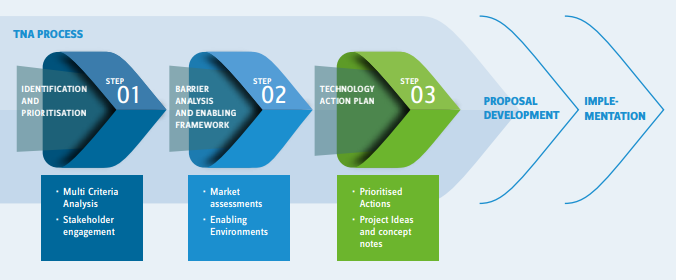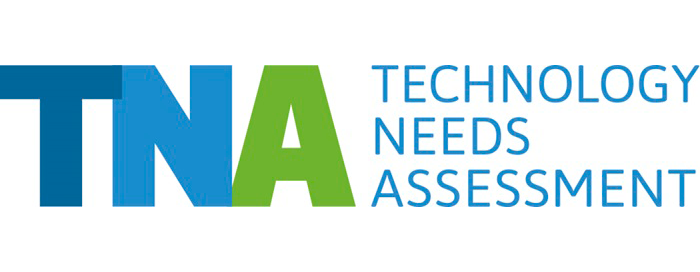TNA Methodology
Methodology
Since its start in 2001, the Technology Needs Assessment’s methodology is now a mature process which has evolved over the years where that it has been used by developing countries. This methodology may also prove useful to developing countries as they work to develop and implement their Nationally Determined Contributions under the Paris Agreement. The Technology Needs Assessment’s process is organised around three main activities:
- Identifying and prioritizing mitigation and adaptation technologies for selected sectors;
- Identifying and analysing the barriers that hinder the successful deployment and diffusion of the prioritized technologies, including its enabling framework;
- Creating, based on the inputs obtained from the previous two steps, Technology Action Plans, i.e., medium- or long-term plans to support implementation of the identified technologies. The Technology Action Plans outline activities that are further elaborated as project concept notes.

Guidance material
This section presents guidance documents produced by UNEP Copenhagen Climate Centre as part of the TNA project covering three broad themes of technology, finance and the process of TNA implementation.
The technology guidebooks cover both mitigation and adaptation themes and the content of these guidebooks is also available in the form of a database on technologies. To explore the various guidance resources please visit Publications, E-learning and Webinars.
Below you can find an overview of the various methodology resources available:

Main Process Guidebooks
The new gender and TNA guidebook familiarizes the reader with gender concepts and demonstrates the relevance of gender issues to climate change adaptation and mitigation, as well as to the relationship between gender and climate in the Sustainable Development Goals. The guide is focused on two key areas of activity: • Institutionalization of gender-mainstreaming by the TNA team in order […]
This guidebook provides practical and operational guidance on how to assess and overcome barriers facing the transfer and diffusion of technologies for climate change mitigation and adaptation. The guidebook is designed to support the analysis of specific technologies, rather than pursuing a sectoral (e.g. transport) or technology group (e.g. renewable energy) approach. Given that there is no single solution to […]
The final step in the TNA process is the preparation of Technology Action Plans (TAPs), which support the implementation of the prioritised technologies, at the desired scale, within the country to achieve the climate and development benefits as identified earlier in the TNA. Concretely, a TAP is built upon the measures identified in a TNA for overcoming barriers to technology […]
Other Process Guidebooks
Determining technologies for climate change adaptation – A hands-on guidance to multi criteria analysis (MCA) and the identification and assessment of related criteria.
A hands on guidance to multi criteria analysis (MCA) in mitigation.
This guidebook is produced as part of the GEF-Funded Global Technology Needs Assessment (TNA) Project, which is implemented by UNEP and UNEP DTU Partnership. Since 2009, close to one hundred countries have joined the Global TNA Project. Indigenous peoples’ knowledge of climate resilience and their global contribution to a sustainable management of our shared natural resources are critical to combating […]
Technology Guidebooks
Sea level rise, more intense storm surges, and other climate change impacts will pose serious threats to large number of people living along the world’s coasts. This guidebook covers thirteen main adaptation technologies for coastal erosion and flooding due to climate change. For each technology, the authors present a technology description, its advantages and disadvantages, costs and benefits, institutional organisation […]
This guidebook provides information on 22 technologies and options for adapting to climate change in the agriculture sector. It describes what policy makers, development planners, agriculture experts and other stakeholders in countries should consider while determining a technology development path in agriculture. NGOs, rural communities and agricultural practitioners could examine and include appropriate options in their portfolios of technologies and […]
This guidebook covers a range of technologies and practices in the agricultural sector related to crops and livestock that can control emission of greenhouse gases, and help improve productivity at teh same time. All the options are dealt with in simple language, and approaches for implementing these technologies are also provided. The guidebook will be used by national TNA teams […]
This guidebook covers a range of transport technologies and practices that can significantly reduce emissions of greenhouse gases and help achieve key development goals at the same time. All the options are dealt with in simple language, and approaches for implementing these technologies are also provided. This guidebook would be used by the national TNA teams which consist of stakeholders […]
This guidebook covers a range of building technologies, design principles and practices which can significantly reduce emissions of greenhouse gases, while improving living and working conditions. All the mitigation technologies and practices are dealt with in simple language and approaches for implementing these technologies are also provided. This guidebook will be used by the national TNA teams which consist of […]
This guidebook is produced as part of the GEF-Funded Global Technology Needs Assessment (TNA) Project, which is implemented by UNEP and UNEP DTU Partnership. Since 2009, close to one hundred countries have joined the Global TNA Project. Urban areas are home to an increasingly large share of the world’s population. As a result, a growing proportion of global greenhouse gas […]
UNEP DTU Partnership together with the Green Technology Center- Korea (GTC – K), a government-funded research institute under the Ministry of Science and ICT Korea, have collaborated on the development of a taxonomy for adaptation technologies in the context of the Technology Needs Assessment (TNA) project. Enhancing the development, transfer and uptake of technology is a key pillar of the […]
Finance guidebooks
This guidebook reviews options for international financing of adaptation actions in developing countries. It presents the most important technical criteria and concepts used by public donors and private financiers in evaluating proposals. It also provides practical advice on how to present project ideas to potential donors. The guidebook is a useful tool for adaptation planners and project developers looking to […]
This guidebook has been created to help developing countries identify and access international financial resources for their climate change mitigation projects and programs. Covering multilateral and bilateral financing institutions and private financing sources, it gives a clear overview about the international funding sources available for mitigations actions in developing countries. It also provides hands-on guidance on how to prepare high […]
Reaching the envisaged scale of climate technology implementation implies a drastic scale-up and implementation of policies and measures, as well as a rapid mobilization of domestic and international financial resources, which should be efficiently and sustainably invested. This guidebook provides information on how to develop a business case for interventions that are inclusive of climate change mitigation and adaptation technologies, […]
Among Parties to the UNFCCC, there is now a broad understanding and agreement on what is needed in terms of technology development, uptake and diffusion to tackle climate change. Moreover, there are well-proven and effective policies and strategies in place to enable a radical transformation. However, there is far less clarity on how to implement them, at scale. These issues […]
TNA Briefs
Africa is among the most vulnerable continents to climate change. By 2030, it is projected that between 75 and 250 million people on the continent will be exposed to increased water stress due to climate change. Enhancing the development, transfer and uptake of climate technology is a key pillar of the international response to climate change. Since 2009, the Technology […]
The region’s developing countries have already replaced developed countries as the largest contributors to GHG emissions, while Asian cities are plagued with some of the highest levels of air pollution in the world. Scaling up technologies that reduce both GHG emissions and air pollution in cities is therefore part of the overarching framework for prioritising technologies within the energy and […]
Countries in Latin America and the Caribbean have a geographically determined vulnerability to the impacts of climate change. Climate change projections show increasing mean temperatures rising by up to 4.5°C compared to the pre-industrial period by the end of the 21st century across the LAC region. Climate change projections are coupled with observed trends in the direction of increased energy […]
This briefing note discusses key linkages between the Sustainable Development Goals (SDGs) and the UNFCCC-mandated Technology Needs Assessments (TNAs), and the role of technology per se in achieving sustainable development. Reflecting on many years of experience in conducting TNAs, the brief includes recommendations on how to sharpen the linkages between country-driven efforts to achieve climate-related SDGs, including how to link […]
